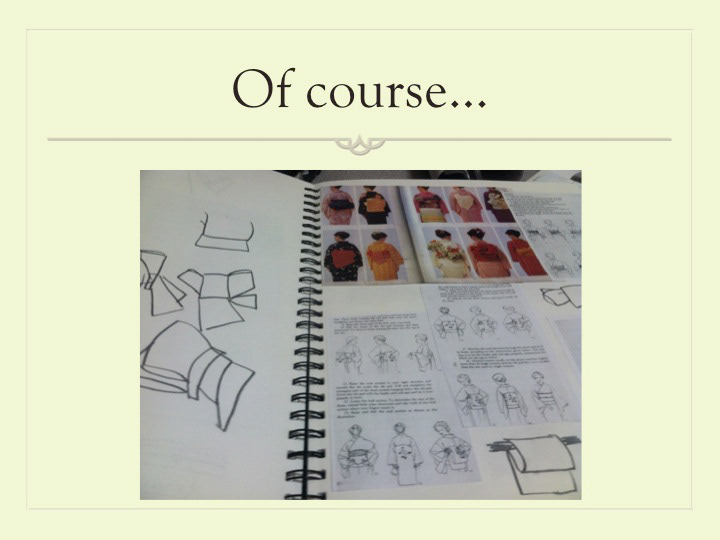

Starting last year, I became very interested in Zero Waste Pattern Cutting, Upcycling, and sustainability in fashion design. I love the idea of creating something new from something old… it allows me to waste less fabric, repurpose something that might’ve become trash, and in the end, made me more creative. My professor, Anne had told me about Timo Rissanen, who is using all these practices and teaching them at Parsons, so I looked him up, found others that are doing good through fashion, and decided to make this my RED DRESS GOAL.

I had to find my fabric and quick, so what’s my favorite vintage shopping spot with huge selection, fast shipping, and quality merchandise? Why, Etsy of course! I had visited Japan in Epcot with my family the summer before and had the idea to repurpose a kimono, so I knew that was the direction that I wanted to take. once I found the one I wanted, I had no idea of the true shade, the construction, or the size of the fabric pieces, so it was a huge surprise and delight to get what I got!

So of course the next step was design research, which I started with research on kimonos and geishas, as well as japanese culture. I was really drawn to the different ways to tie the obi, and process of dressing, and the layers involved in the dressing process. I decided to focus on the knots and the idea that the shapes and layers are always changeable.

So I started playing with the odd layers and shapes of the knots on the body, and eventually decided to morph these two VERY rough sketched to make a wide dress with knot detail and a small jacket. The whole process of sketching was plagued with worries that I wouldn’t have enough fabric, so this effected my designs. But not having the actual dress added a level of uncertainty, so waiting to finalize was important.

I decided that my customer would be a young professional, somewhere from 25-35 years old, and married with no children. She works as a television professional and aspires to create and on-screen career someday, so she needs interesting pieces to wear to events and on the air. She shops at high end boutiques and lives in Chicago, Illinois. As far as personality goes, I conceived that she’d be environmentally minded, a little quirky but still sophisticated. My dress would be in the Young Designer Market, selling for a bit over $400.

Once I finally got my kimono in the mail, I had the delight of taking it all apart, which was heartbrekaing because there was a million different hand and machine stitches in a million different colors. You could tell that this kimono had seen a lot of different owners and a lot of repair, and possibly had already been recycled once. This also created a new panic for me as I’m taking it apart and realizing that it’s in a dozen small and thin pieces, which necessitated changes to my design.

So once I saw what I was working with, I finalized my design, bought an additional recycled kimono fabric to use as an accent, and set out to drape my dress and jacket. I had to drape with the pieces of my final fabric, hand basting the grain line and style lines onto the fabric as I went to make sure that the pattern pieces would fit when I went to cut. There were some casualties along the way, but we eventually got to making patterns.

It took a while for my contrast fabric to come (from Australia), so I had to wait to drape the knot on the dress, because I wasn’t sure of the size of the piece, the placement of the pattern, or the hand of the fabric. I struggled with fullness and the placement of the knot because I thought too much looked like a bad 80’s bridesmaid dress and too little looked cheap. I also had to figure out the knot in a way that the face of the fabric would show on both sides. My spacial skills were really important for this step.

Once I got to making my muslin, I ran into problems with the sleeves of the jacket, which were way too small, the hem line of the jacket, which was way too low, and the closure of the dress. The closure was difficult because I had unusually placed seam lines and a strictly finite amount of fabric. I eventually decided on putting a zipper in the foundation and closing the shell with a placket, hook and eye, and snaps (the original ones from the kimono). The road block that I ran into with the sleeves for baby arms turned out to be a happy accident and provided for a much more interesting sleeve shape and seaming detail.

Fitting the pieces on the panels of the kimono proved to be harder than I’d planned, so I was really proud when I fit these three all on one long panel, the one that layed around the neck of the original kimono. I ended up with one piece that didn’t fit on the panel that it was intended for, so the fabric that I saved by solving this little jigsaw went to the two pattern pieces that I had to make out of the one ornery one that didn’t fit.

Hand-basting the dress together was the next step toward the final product, and while the silhouette is fairly simple, the many panels, intricate closure, and sleeves were difficult to hand sew. An unforseen upside to having to hand baste it together was that as long as my first stitch was in the right place, I could just run it through the machine!

